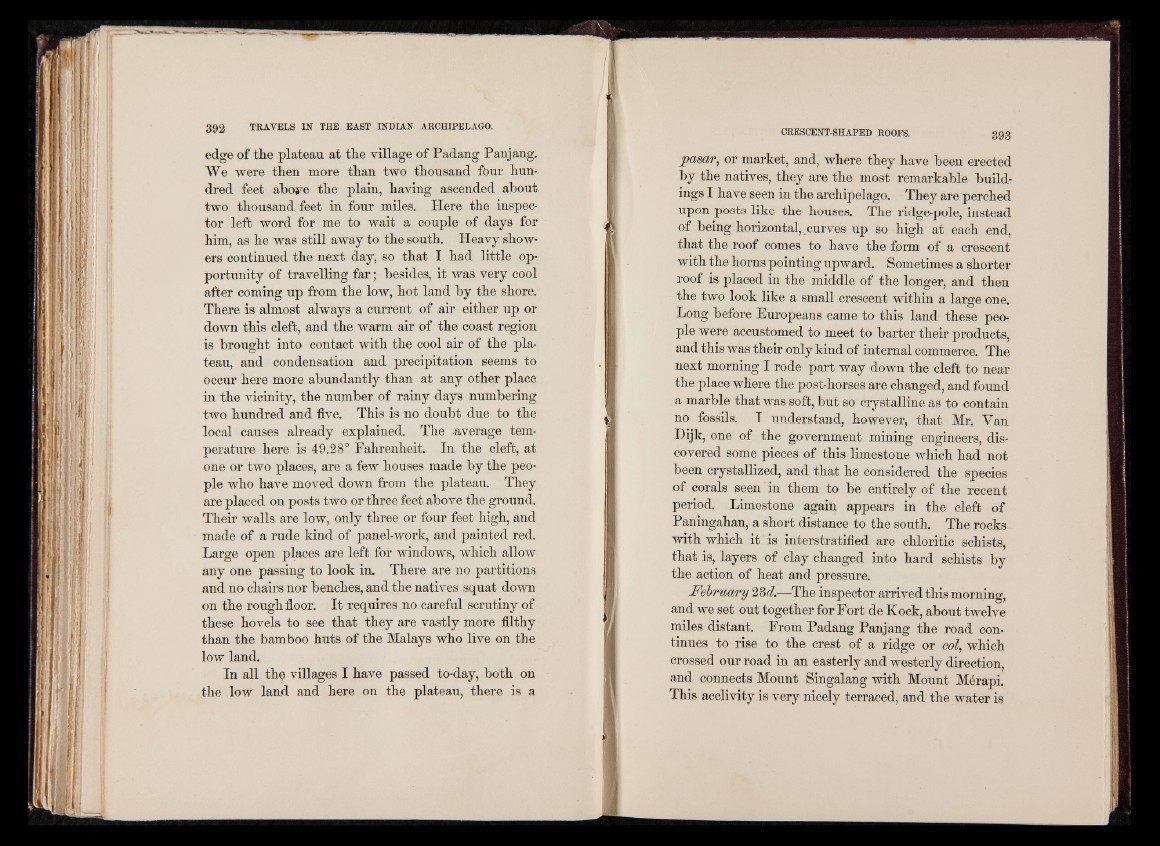
edge of the plateau at the village of Padang Panjang.
We were then more than two thousand four hundred
feet aboyo the plain, having ascended about
two thousand feet in four miles. Here the inspector
left word for me to wait a couple of days for
him, as he was still away to the south. Heavy showers
continued the next day, so that I had little opportunity
of travelling fa r; besides, it was very cool
after coming up from the low, hot land by the shore.
There is almost always a current of air either up or
down this cleft, and the warm air of the coast region
is brought into contact with the cool air of the plateau,
and condensation and precipitation seems to
occur here more abundantly than at any other place
in the vicinity, the number of rainy days numbering
two hundred and five. This is no doubt due to the
local causes already explained. The -average temperature
here is 49.28° Fahrenheit. In the cleffc, at
one or two places, are a few houses made by the people
who have moved down from the plateau. They
are placed on posts two or three feet above the ground.
Their walls are low, only three or four feet high, and
made of a rude kind of panel-work, and painted red.
Large open places are left for windows, which allow
any one passing to look in. There are no partitions
and no chairs nor benches, and the natives squat down
on the rough floor. It requires no careful scrutiny of
these hovels to see that they are vastly more filthy
than the bamboo huts of the Malays who live on the
lo w land.
In all the villages I have passed to-day, both on
the low land and here on the plateau, there is a
pasar, or market, and, where they have been erected
by the natives, they are the most remarkable buildings
I have seen in the archipelago. They are perched
upon posts like the houses. The ridge-pole, instead
of being horizontal, , curves up so high at each end,
that the roof comes to have the form of a crescent
with the horns pointing upward. Sometimes a shorter
roof is placed in the middle of the longer, and then
the two look like a small crescent within a large one.
Long before Europeans came to this land these people
were accustomed to meet to barter their products,
and this was their only kind of internal commerce. The
next morning I rode part way down the cleffc to near
the place where the post-horses are changed, and found
a marble that was soft, but so crystalline as to contain
no fossils. I understand, however, that Mr. Van
Dijk, one of the government mining engineers, discovered
some pieces of this limestone which had not
been crystallized, and that he considered the species
of corals seen in them to be entirely of the recent
period. Limestone again appears in the cleffc of
Paningahan, a short distance to the south. The rocks
with which it is interstratified are chloritic schists,
that is, layers of clay changed into hard schists by
the action of heat and pressure.
February 23d.—The inspector arrived this morning,
and we set out together for Fort de Kock, about twelve
miles distant. From Padang Panjang the road continues
to rise to the crest of a ridge or col, which
crossed our road in an easterly and westerly direction,
and connects Mount Singalang with Mount Merapi.
This acclivity is very nicely terraced, and the water is